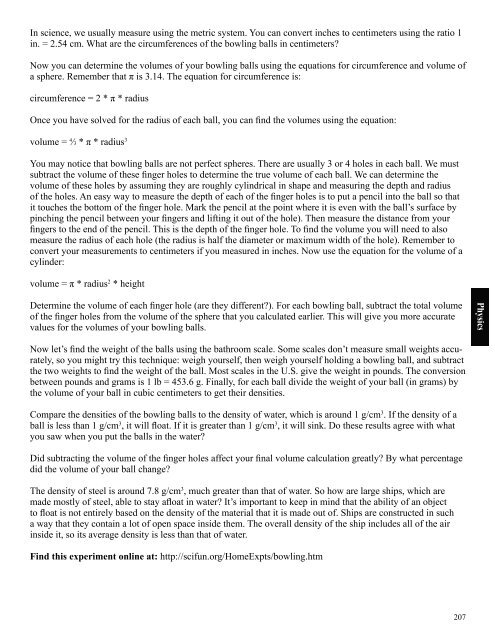ScienceMakers Toolkit Manual - The History Makers
ScienceMakers Toolkit Manual - The History Makers
ScienceMakers Toolkit Manual - The History Makers
Create successful ePaper yourself
Turn your PDF publications into a flip-book with our unique Google optimized e-Paper software.
In science, we usually measure using the metric system. You can convert inches to centimeters using the ratio 1<br />
in. = 2.54 cm. What are the circumferences of the bowling balls in centimeters?<br />
Now you can determine the volumes of your bowling balls using the equations for circumference and volume of<br />
a sphere. Remember that π is 3.14. <strong>The</strong> equation for circumference is:<br />
circumference = 2 * π * radius<br />
Once you have solved for the radius of each ball, you can fi nd the volumes using the equation:<br />
volume = 4 ⁄3 * π * radius 3<br />
You may notice that bowling balls are not perfect spheres. <strong>The</strong>re are usually 3 or 4 holes in each ball. We must<br />
subtract the volume of these fi nger holes to determine the true volume of each ball. We can determine the<br />
volume of these holes by assuming they are roughly cylindrical in shape and measuring the depth and radius<br />
of the holes. An easy way to measure the depth of each of the fi nger holes is to put a pencil into the ball so that<br />
it touches the bottom of the fi nger hole. Mark the pencil at the point where it is even with the ball’s surface by<br />
pinching the pencil between your fi ngers and lifting it out of the hole). <strong>The</strong>n measure the distance from your<br />
fi ngers to the end of the pencil. This is the depth of the fi nger hole. To fi nd the volume you will need to also<br />
measure the radius of each hole (the radius is half the diameter or maximum width of the hole). Remember to<br />
convert your measurements to centimeters if you measured in inches. Now use the equation for the volume of a<br />
cylinder:<br />
volume = π * radius 2 * height<br />
Determine the volume of each fi nger hole (are they different?). For each bowling ball, subtract the total volume<br />
of the fi nger holes from the volume of the sphere that you calculated earlier. This will give you more accurate<br />
values for the volumes of your bowling balls.<br />
Now let’s fi nd the weight of the balls using the bathroom scale. Some scales don’t measure small weights accurately,<br />
so you might try this technique: weigh yourself, then weigh yourself holding a bowling ball, and subtract<br />
the two weights to fi nd the weight of the ball. Most scales in the U.S. give the weight in pounds. <strong>The</strong> conversion<br />
between pounds and grams is 1 lb = 453.6 g. Finally, for each ball divide the weight of your ball (in grams) by<br />
the volume of your ball in cubic centimeters to get their densities.<br />
Compare the densities of the bowling balls to the density of water, which is around 1 g/cm 3 . If the density of a<br />
ball is less than 1 g/cm 3 , it will fl oat. If it is greater than 1 g/cm 3 , it will sink. Do these results agree with what<br />
you saw when you put the balls in the water?<br />
Did subtracting the volume of the fi nger holes affect your fi nal volume calculation greatly? By what percentage<br />
did the volume of your ball change?<br />
<strong>The</strong> density of steel is around 7.8 g/cm 3 , much greater than that of water. So how are large ships, which are<br />
made mostly of steel, able to stay afl oat in water? It’s important to keep in mind that the ability of an object<br />
to fl oat is not entirely based on the density of the material that it is made out of. Ships are constructed in such<br />
a way that they contain a lot of open space inside them. <strong>The</strong> overall density of the ship includes all of the air<br />
inside it, so its average density is less than that of water.<br />
Find this experiment online at: http://scifun.org/HomeExpts/bowling.htm<br />
207<br />
Physics










